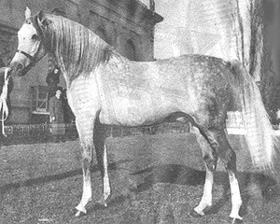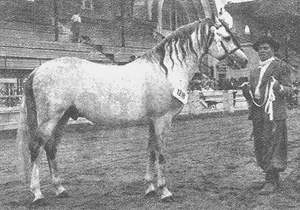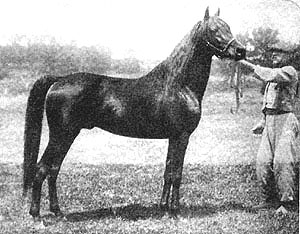
Salam (Actif x Sedi)
In the last decades of the 18th century in Argentina began a time of prosperity based upon the politic stability and a strong agricultural production. In the ground seems to be the future of the country and the enriched and powerful big estate owners went to Europe to import quality breeding stock to improve the local breeds.
Hernan Ayerza loves the country life much more than Buenos Aires and in despite of the family tradition he chooses to work in the estancia of Leonardo Pereyra, one of Argentinas most influential big estate owners. There were a lot of diferent horse breeds on his estancia, including a few arabian stallions who woke up the fantasy of the young and romantic man.
Once married he went with his wife Maria Moreyra to the Orient to choose personally the foundation stock of his stud. On his first journey in 1892 and after sawing hundreds of arabians at the markets and private stables of Constantinople, Damascus and Beirut he bought the chestnut stallion Gailan a Koheilan Ajuz and the grey mare Maanaqui. With a special permission he was able to export this horses to Argentina and and start his stud El Aduar.
With the knowledge of conditions and problems in the Orient, his second travel in 1898 was carefully prepared. He came back with the bay mare Haydee, a famous Kehilet-el-ajuz from the Sebaa bedouins of Amarat, Gelue another Kehilet-el-ajuz, Kariban a chestnut seglawi-el-jedran, a half-sister of the Blunt stallion Azrek, and the stallions Dayman, Hadi, Marum, Richam and Sackat.
The first outstanding product of the breeding of El Aduar was the stallion Haurram II. He was born in 1912 by Racid (Hadi x Rakeb) out of Haydee. Lady Wentworth, the owner of the british stud Crabbet Park, offers a change with her famous stallion Skowronek for Haurram II. But the change couldn't take place.
 |
Hernan Ayerza don't use inbreeding; he began with a few mares but need continuos new stallions. The desert breds were the first he uses; in 1913 he lend from his brother-in-law, Felix Buxareo y Oribe, the founder of arabian horse breeding in Uruguay, two stallions: the french bred Hamla and Ajman (Feysul x Ajramieh) who came from Crabbet Park. Specially Ajman had a lot of good daughters in Argentina and in this way Crabbet Park became the primary source for Argentinas outcross stallions: Rustnar (Rustem x Narghileh), Risfan (Rijm x Risala) and Nachor (Sotamm x Nessima) were imported, but the last of the three had not the quality Don Hernan expected and was retired from the El Aduar. Other stallions came from France: Kemmel and Actif and from Germany: Kurdo III. |
|
Salam (Actif x Sedi) |
Hernan Ayerza don't sold his arabians, he prefered to use them at the grasslands and the farm work or to give them to friends or relatives. But in 1926 he made an exception and sold 10 arabian mares to the Duke of Veragua in Spain. Unfortunatly some years later the Duke was murdered in the civil war, his castle burned down and the identity of most of his mares and fillies lost. We do not know were of the so-called "Veragua-mares" descend from the argentinan importation. Another exportation went to Brasil, to the Coudelaria Nacional de Saycan and to Guillermo Echenique filho, one of the first arabian breeders of Brasil.
In 1928 the sirian family Vittar had to move from Buenos Aires to Santiago del Estero. They can't take their loved family mare with them and sold her to El Aduar. Sedi was after Maanaqui, Haydee and Kariban the fourth mare that founded an own strain in El Aduar. She had been imported from Siria; her coat colour was grey and she was out of the abeyan strain. Her quality was proofed by her production: four foals - three national champions, and the fact that the family Vittar after three generations still reminds their grey mare.
New breeding stock came in 1931 through Carl Raswan when Hernan Ayerza was able to get four horses directly from the desert. The stallions Farhan and Tatar and the mares Diya, a Hamdanieh simri, and Richa, a Kehilet. Richa became national champion mare in 1932 but died the following year. Her only foal in Argentina, the stallion Rimadi (by Farhan) and later National Champion did much to recompense the loss of his mother.
| Hernan Ayerza was 80 years old as he imported a new stallion: Harmattan from Brasil. He was by the Skowronek-son Nahrawan out of a Haurram II-daughter. It was the last importation. In 1940 Hernan Ayerza died but the breeding in El Aduar was continued by his wife Maria Moreyra and his nephew Rafael Ayerza. |  |
|
Nobah (Rimadi x Nahal) |
Hernans brother Alfonso came to the arabian horses some years later. We do not know if it was admiration for his brothers horses or if Sterling, an arabian stallion born in Hungria and imported to use for his Trakehner mares, convenced him about the adventages of the arabian horse.
While Hernan Ayerza looks for a greater arabian, Alfonso prefers breeding the smaller and typier one. And since his his brother depends upon new stallions, Alfonso uses his foundation stock trough near two decades without any new blood.
He went his own way and bought his foundation stock in the National Stud of Hungria, Babolna, in Crabbet Park and in France. His foundation horses were the stallions Hamdani Semri I-9, born in 1905 Rukham (Berk x Rabla) born in 1912 and the desertbred Seglaani al Abdi. His mare lines are based on the hungrian mares O'Bajan V-6, O'Bajan 7 and Hadban I-4, the Crabbet born Nadima (Daoud x Nefisa) and the french Djellah.
 |
In 1921 the Nebal was born. He was by Rukham out of the mare Mottaka (Hamdani Semri I-9 x O'Bajan V-6), and became one of the most influential stallions in Argentina, founder of an important and widespread sire-line in South America. Don Alfonso Ayerza uses, in diference of his brother, inbreeding. And the best Nebal-stock was obtained by Faraya-daughters. Faraya was a half-brother of Nebal through his mother Mottaka. |
|
Nebal (Rukham x Mottaka) Photo from Mary Lockwood |
The best stallions of his stud shows this combination: Mebáttan, who was sold to Uruguay, Mefrúk and Kalb. But there were also daughers of Nebal out of this early "golden cross": Negása, for example, the mother of the stallions Agzab (sold to Uruguay), Kedive and Xarrar and the mare Quelmá, National Champion Mare in 1942.
| While Hamdani Semri I-9 was not able to establish
an own sire-line (only one son of him was used for breeding in Uruguay)
the desertbred Seglaani al Abdi do it. From his four sons Uzúl
and specially Faraya made good daughters, but Farág
and Muálem founded own strains of this line. The Muálem-son
Zbaa-Quebir was sold to the brazilian government and became an important
sire in their breeding program.
Through the Muálem-grandson Belkacen this line came to present times and there are still a few stallions out of this line in produccion. |
 |
|
Zbaa-Quebir (Muálem x Haramüa) Photo from Mary Lockwood |
After breeding a lifetime long both brothers decided to profit from each others work. Hernán Ayerza sent two mares to be covered by Alfonsos stallions. The resulting foals were Nahal by Nebal (mother of Nobah) and the stallion Ayenat (Muálem x Abbaia).
Alfonso Ayerza added the stallions Ain and Hembél (Adchi x Haua) and continue with the way traced years ago, crossing only his own horses. He died in 1942 at the age of 80.

Ain (Haurram II x Akka by Ajman)
Photo from Mary Lockwood
___________________________________________________________________________
___________________________________________________________________________